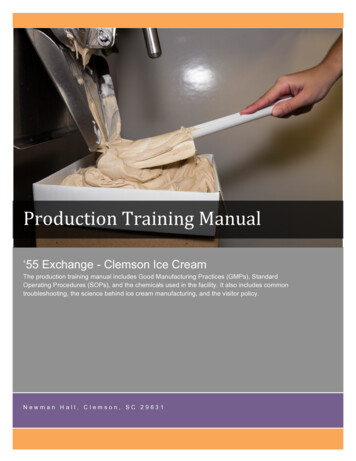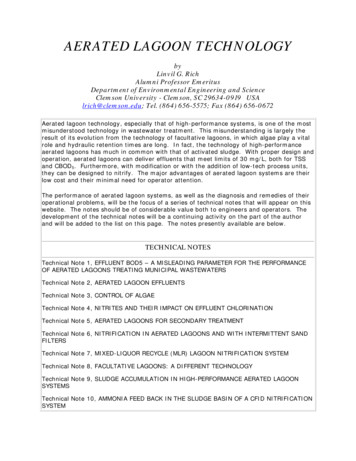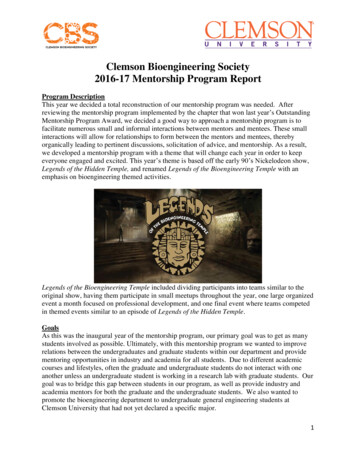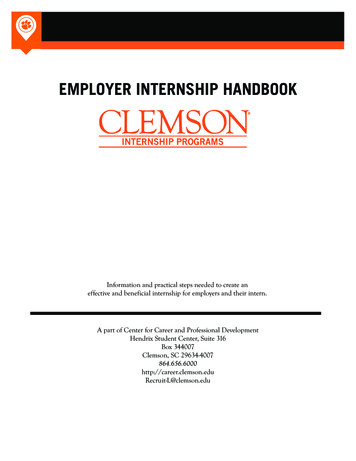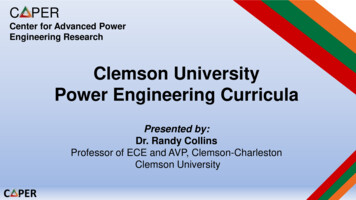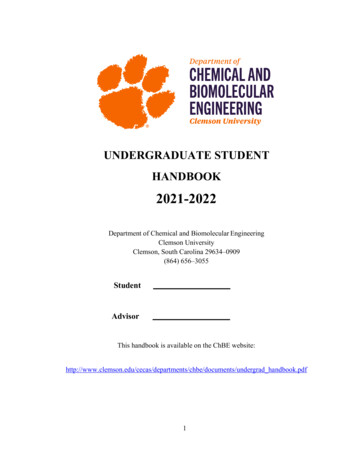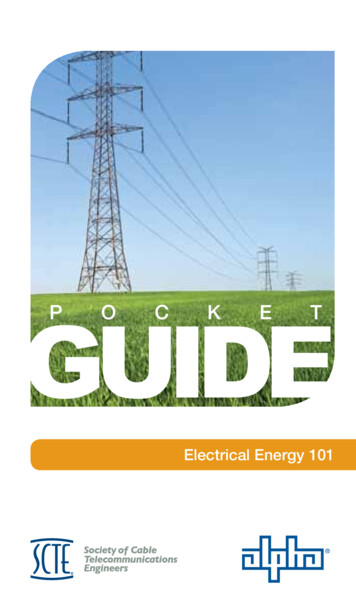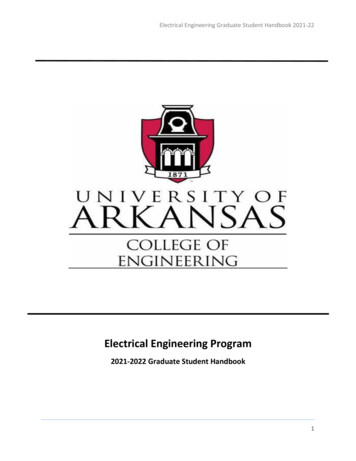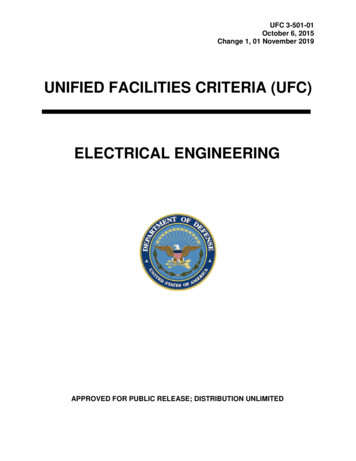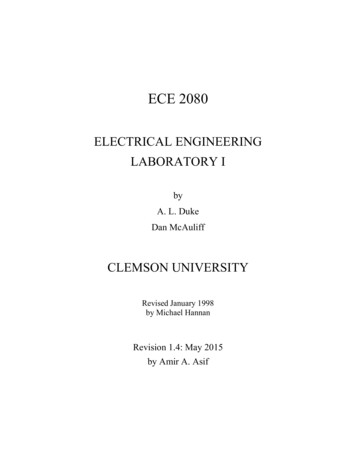
Transcription
ECE 2080ELECTRICAL ENGINEERINGLABORATORY IbyA. L. DukeDan McAuliffCLEMSON UNIVERSITYRevised January 1998by Michael HannanRevision 1.4: May 2015by Amir A. Asif
Revision Notes1991 Authors: A. L. Duke and Dan McAuliff. Original release.1998 Author: Michael Hannan. Reorganization, mostly with same information.2008 Author: James Harriss. General reorganization, corrections, and update. Clarifiedinstructions to reduce equipment damage and blown fuses. Redrew many figures.Rewrote laboratory sessions on SPICE and Oscilloscope. Added equipment list andreferences. Created common Appendix (A to E) for ECE 309 and ECE 212. MovedSafety and Oscilloscope background information into Appendix. Added appendix forTektronix TDS 1002B Oscilloscope. August 2008.2010 Author: Dr. J. E. Harriss. In Lab 5 - Oscilloscope: Add explanation of RMS and clarifypurpose of the experiment; delete procedure 5, Lissajous figures. May 2010.2015 Author: Asif Amir. Simulation lab rewritten. Appendix F added. Re-arranging the orderof labs to keep pace with the co-requisite course. Alternate method added in instrument(voltmeter) characterization. Pre-lab and post-lab redefined in circuit analysis chapter.ECE 309ii2015
Table of ContentsRevision Notes . iiTable of Contents . iiiEquipment . ivReferences . vPreface. viIntroduction . viiPreparing the Laboratory Notebook. viiiReports . xLaboratory #1: Course Description and Introduction . 1Laboratory #2: Measurement of DC Voltage and Current . 2Laboratory #3: Computer Analysis . 4Laboratory #4: Instrument Characteristics. 7Laboratory #5: Problems: Circuit Analysis Methods . 13Laboratory #6: Network Theorems . 17Laboratory #8: Oscilloscope . 22Laboratory #9: Problems: AC Power Calculations . 25Laboratory #10: AC Measurements . 26Laboratory #11: Problems: Operational Amplifiers and Digital Logic . 28Laboratory #12: Digital Logic Circuits . 29Appendix A Safety . 31Appendix B Equipment and Instrument Circuits. 36Appendix C Data Plots . 49Appendix D Operating Instructions for a Typical Oscilloscope . 51Appendix E Tektronix TDS 1002B Oscilloscope . 57Appendix F Simulation Tool: PartSim . 63ECE 309iii2015
EquipmentDescriptionManufacturerModelAC Power Supply .use Autotransformer or Transformer BoardAmmeter-Voltmeter, Analog .HampdenACVA-100Autotransformer (Variac).Powerstat3PN116CCapacitance Decade Box .EICO1180Capacitor, 40 mfd.Square DPFC2001CDC Power Supply .TENMA72-7245Digital Designer .Digi-DesignerDD-1Frequency Counter .TektronixCFC250Function Generator .BK Precision4011A, 5MHzInductor, 10 mH .ECEInductor, coaxial, 36mH, 28mH, 120mH .ECELCR Meter .BK Precision878Multimeter, Digital, True RMS .MetermanWavetekBDM40BDM40Oscilloscope, Dual Beam .TektronixTDS1002B or TDS1002Resistance Load Box.ECEResistance/Reactance Load Box .HampdenRLC-100Resistor Decade Box, High Power.Clarostat240CResistor Decade Box, Low Power .HeathkitIN-3117Transformer Board .mounted 120V to 6.3V & 12.6V transformerTwo-port Network .ECEVoltmeter, Analog.HampdenAC3V-300Voltmeter-Ammeter, Analog .HampdenACVA-100Wattmeter, Dual Analog .HampdenACWM-100ECE 309iv2015
References1. Giorgio Rizzoni, Principles and Applications of Electrical Engineering, Fifth Edition,McGraw-Hill, December 2005.2. Giorgio Rizzoni, Principles and Applications of Electrical Engineering, Revised FourthEdition, McGraw-Hill, July 2003.3. Mahmood Nahvi, Joseph A. Edminister, Schaum's Outline of Electric Circuits, FourthEdition, December 2002.4. James W. Nilsson and Susan Riedel, Electric Circuits, 8th Edition, Prentice Hall, May 2007.5. James W. Nilsson and Susan Riedel, Electric Circuits, 7th Edition, Prentice Hall, May 2004.6. Charles Alexander, Matthew Sadiku, Fundamentals of Electric Circuits, Second Edition,McGraw-Hill, May 2004.ECE 309v2015
PrefaceThis laboratory manual is composed of three parts. Part One provides information regarding thecourse requirements, recording the experimental data, and reporting the results. Part Twoincludes the laboratory experiments and problem exercises to be performed. Part Three is anappendix with sections regarding electrical safety, general equipment in the laboratory, creating alogarithmic scale for graphs, general information about oscilloscope use, and specificinformation about the oscilloscopes available in the laboratory.ECE 309vi2015
IntroductionThis laboratory course operates in co-ordination with the companion lecture course, ECE 2070,Basic Electrical Engineering. Each course complements the other: Several ECE 2080 exercisesrequire knowledge of theory developed in ECE 2070, and several assist in understanding ECE307 concepts.Preliminary laboratory preparation (“Pre-Lab”) is assigned for most periods. A student whounderstands this preliminary preparation should be able to complete the exercises during the timescheduled.Much of the value of the laboratory exercises lies in working with the instruments and otherelectrical equipment; therefore, attendance is required. Since the laboratory facilities are in usealmost every period of the week, it is difficult to schedule make-up periods to complete the work.If absence is unavoidable, the instructor can usually assist in arranging a meeting with anothersection.The instructor of each section will inform that section of policies regarding tests, ethics, themethod of determining grades, and other administrative matters during the first-periodorientation.This laboratory course has five major objectives: (1) Familiarization with basic electricalmeasurement techniques, (2) Enhancing ability to apply electrical theory to practical problems,(3) Practice in recording and reporting technical information, (4) Familiarization with electricalsafety requirements, and (5) Laboratory verification of some elementary theorems and conceptsof electrical engineering. These objectives are to be accomplished by a series of laboratoryexercises and problem sessions.The laboratory exercises are generally focused on electrical instrumentation, with one periodfocused on using a digital computer program to analyze electrical networks.The problem sessions are coordinated with the theory covered in the lecture. The problemsessions involve two types of problems: (1) those that are of a more applied nature, such asapplication of theorems to bridge circuits, and (2) those for which the topic requires little or nolecture, such as determination of shunts and multipliers to change the scale of ammeters andvoltmeters. While some assigned problems are similar to those in the text, others extend the textmaterial in order demonstrate how the theory can be applied to basic problems encountered ingeneral engineering practice.ECE 309vii2015
Preparing the Laboratory NotebookLaboratory-oriented engineering work, particularly research work, provides information that isusually quite detailed. Records of this work and the results specified are kept in laboratorynotebooks. Laboratory notebooks must be complete and clear, since data recorded may provide abasis for calculations, conclusions, recommendations, engineering designs, patents, etc. Thesenotebooks are given to the engineer to generate various types of reports, sometimes after longperiods of time. They may be used by others to verify the work, or as a base for additional work.They also may serve as evidence in lawsuits over patents. While the format of the notebook is anindividual matter, certain standards must be maintained to ensure accuracy and readability.The requirements and procedures necessary to produce a good laboratory notebook are given inthe following paragraphs. The lead page or pages of the laboratory notebook should containgeneral information, such as title, purpose, and laboratory location. The information recorded inthe laboratory notebook should be sufficiently detailed to permit the work to be duplicated at alater date by the writer or by other knowledgeable engineers. It should include all data observedand the pertinent conditions that existed, such as instruments used, parameter settings, and so on.Entries in the notebook should be in chronological order and should be in ink. Any erroneous orincorrect entries should not be erased, but should be lined through. Pages should be numberedconsecutively, with no pages removed or torn out. No blank pages should be left. Any pages orpartial pages left blank should be lined through. Each entry should be dated and signed and, ifappropriate, witnessed. Dating, signing, and witnessing are especially important when pursuingor protecting patents.Types of entries in a laboratory notebook include concise written explanations of procedures,equations used, freehand sketches and diagrams, tables, curves, charts, photographs, lists ofapparatus, and references to items such as blueprints that are large or bulky to include.The laboratory notebook normally should not contain lengthy presentation theory or referencematerial, or extended discussions of ordinary or routine results. Written explanations should besufficiently detailed to permit the writer to understand what was done even after several yearshave elapsed, but should not be burdened by trivial details.Any equation used in the work should be given in the notebook, along with source of theequation, if it is not a standard, well-known one.Freehand sketches should be used liberally to illustrate laboratory experiments. These sketchesshould be neat. Straightedge and compass or suitable drawing templates should be used to obtain,as a minimum, straight lines and round circles. Using templates for sketching standard devicessuch as resistors, inductors, and capacitors also improves the appearance of the notebook. Theengineer doing the recording must decide on the trade-off between the time required and theappearance and readability the notebook.Tables should be used to list observed data as well as data calculated during laboratory work.These tables should be titled with the conditions that existed or parameters that were set.Headings for columns and rows should be given with the units used in the measurement orcalculations. It is frequently desirable to separate observed data and calculated data in tables byuse of a double rather than a single line. Where calculated data is tabulated, the table should befollowed by representative sample calculations.ECE 309viii2015
Graphs and charts are frequently used during laboratory work to determine validity of the dataand to detect immediately anomalies, trends, and unexpected changes in the data; this may avoida need for repeating the experiment later. It is much more expensive in time and material to setup the experiment a second time needlessly, rather than correcting the problem during the firstrun. Photographs, charts, oscillograms, diagrams, and other loose sheets are sometimes desirablein a notebook. These should be attached or affixed in the most suitable and permanent manner.Any pertinent material, such as blueprints, which cannot be reduced sufficiently for inclusion inthe notebook, should be referenced and filed so as to be available as long as the notebook is to bekept.Instruments or other apparatus affecting the work should be listed in the notebook. The name,manufacturer, equipment type, model, rating, and serial number of the item should be recorded,as appropriate.The instructor may or may not require a formal lab notebook in this course. If required, carbonpaper will be provided.References1. J. N. Ulman, Jr. and J. R. Gould, Technical Reporting. Third Edition, Holt, Rinehart, andWinston, Inc., New York, 1972.2. B. D. Wedlock and J. K. Roberge, Electrical Components and Measurements. Prentice-Hall,Inc., Englewood Cliffs, NJ, 1969.ECE 309ix2015
ReportsGeneralThe final result of almost all engineering work includes some sort of report. The information forthe report usually comes from the engineer’s notebook, status reports, design information, andother reports. It follows that a good engineer must be skilled at transmitting technicalinformation, whether by a long formal report or by a short telephone conversation. Examples ofthe types of informational reports commonly used by engineers are:-Routine periodic (e.g., biweekly) reports to a supervisor on activities carried out during thetime period.-Special reports on projects, investigations, etc., to a supervisor or to management.-Informational reports to others regarding work done to provide the information needed to dothe job.-Routine (monthly, quarterly, etc.) project reports to a project director, or from you as aproject director to management or to clients.-Informational and fiscal status reports to the management and controllers.-Informational reports needed by people being supervised.The informational report is written to provide information on the results of specific work done. Itwill vary from a very short report (e.g., a telephone conversation or one-page laboratory report)to a comprehensive formal technical report that requires weeks or months and many people toprepare. The informational report is the type used in technical laboratories and in engineeringdesign correspondence.The major characteristics of a good technical report can be summed up as conciseness,completeness, accuracy, and clarity. Conciseness is important since a wordy report or one withunneeded information is often put aside and not read, or only scanned. Completeness isimportant since lack of needed information may require additional work to get the information,causing delay of a project, or it may result in wrong decisions being made. Accuracy is importantsince any error in content (or in write-up) generally makes the whole report suspect. Clarity,along with accuracy, is a primary requirement since ambiguities or misinterpreted statements aresynonymous with errors.Other characteristics, such as objectivity, authoritativeness, coherence, control, direction,organization, and veracity are also important, and are discussed in more detail in the references.One of the most important but often overlooked steps in preparing a good report is the selectionof the appropriate audience. A technical report addressed to a few people with similarbackground and knowledge of the subject can be written more easily than one addressed to anaudience of varied backgrounds. In reports for people of similar backgrounds, superfluousinformation must be omitted. In writing to a group with different types of backgroundknowledge, care must be used to include the required information without requiring all thereaders to read and comprehend all the material. Perhaps the worst technical reports are thosewritten to the wrong audience.ECE 309x2015
Judgment must be used in establishing sections and subsections in all types of reports. It is just asinappropriate to have a one page report with twenty section headings as it is to have a fifty-pagereport with only one heading. Where appropriate, elements may be combined and renamed.In this course, two types of reports will be used: the Laboratory Report and the Memo Report.Both are described in the following paragraphs.Memo ReportThis should be a brief report limited to a single subject. It is usually limited to communicationwithin the organization. The memo may be from one-half to five or ten pages long. In addition tothe technical information, it should always have a date, a reference line, a "To" line, a "From"line, and a signature or initials. It may also have a heading (e.g., organization or company name),subject line, identification symbol, distribution notice, and attachment or enclosure notice. Mostorganizations, through regulations or through custom, have standard or semi-standard formats forthe heading lines.Some common types of memo reports are the progress report and the status report. These tworeports are similar but the status report usually is more comprehensive and less specific. Itfrequently includes such things as costs and man-hours expended, while the progress report mayonly provide information on the work that has been done, the work being done, and the workplanned. The progress report should point out problems as well as the steps being taken toovercome these problems. Unexpected progress should be presented. Recommended changes canalso be included; however, such recommendations may be better addressed with a separatememorandum in order to receive more immediate attention.Laboratory ReportsThis category of report includes types of reports that vary from the standard fill-in-the-blank type(e.g., test results from standard, well-known, performance tests of transformers) to the individualcomprehensive report, very similar to the formal report (e.g., one resulting from the individuallaboratory testing of a large, expensive piece equipment). The format will, of course, depend onwhere the report lies between these extremes. However, all laboratory reports should answer thefollowing questions in a straightforward, smooth-flowing manner:1. What was the objective of the test or experiment?2. How was it performed?3. What information or data were obtained?4. What is the result and significance of the information and data?5. What are the conclusions to be drawn, as related to the objective of the test or experiment?The laboratory report is the communication vehicle frequently used to combine the appropriatetest or experimental data from the laboratory notebook with information from other sources andto transmit it to the person or organization that needs it. This type report is also frequently usedas an undergraduate student laboratory report.The following paragraphs give the headings and a brief description of sections of a typicallaboratory report.Heading. This varies from the title page of a formal report to the heading of a memo or letterreport. It is the writer’s responsibility to find out what is appropriate in each case. The headingECE 309xi2015
should include the report title and the report number. Reports without numbers and names arelikely to be misfiled and lost. On a student report, the date should be the date the report is due.Objectives. This section should carefully state the objectives or purpose of the test or experiment.It should be edited very carefully to avoid vagueness and ambiguities. In a student report, theobjectives should not necessarily be just a copy of the purpose or objective specified in the labmanual, but should state the objectives or purposes of the test or experiment as it was done.Apparatus or Equipment. This should be a listing of all equipment, instruments, and devicesused. General-purpose items, such as wire, resistors, or other items which do not affect theresults should not be included. The listing should include name, manufacturer, model, and typenumber, and rating of the equipment.Procedure. A narrative account of the method and procedures used in carrying out the laboratorywork is written in chronological order, and should briefly describe the work accurately as it wasdone. Diagrams, sketches, and pictures should be liberally used. In beginning student exercises,the procedure is usually fully given by the instructor, but in more advanced exercises, studentsmay be required to develop their own procedures.Observation and Discussion. This section should contain the data or recorded observations fromthe laboratory work. This is usually in tabular form and may include calculated data as well asobserved data. It may also include narrative comments on the significance of the data,comparison of analytical and experimental values, and answers to specific questions.Conclusions. This section is similar to the conclusions section in the formal report. Theconclusions reached should be clearly supported by specific data in the observation section, andshould be closely related to the experimental objectives.Signature. The person responsible for the work and the report should sign the report signifyingacceptance of responsibility for the report. In some instances, this also requires the engineer’s,registration number as a professional engineer, thus accepting legal responsibility for the workdone. In shorter reports; the signature may a part of the heading section. In student reports, itsignifies that the report is the students work with no unauthorized assistance from other studentsor reports.The report may also include other sections, such as Analysis and Calculations, TheoreticalDevelopment, and Recommendations. The report should be organized with section headingsselected to provide the reader with an organized, smoothly moving path through the report. Itmay be suitable to give all procedures followed by observations, then followed by allconclusions; or it may be preferable to organize the report in sections with procedure,observations, and conclusions for one part of the experiment, followed by procedure,observations, and conclusions for another part. The writer should very clearly identify theprocedures, observations, and conclusions, and should never intermingle them in one paragraph;however, neither should the reader be forced to continually turn back and forth between sections.The report should be written in relatively formal language. Technical vocabulary should be usedas appropriate, but technical vocabulary that the reader could not be expected to know should bedefined in a glossary, in a footnote, or by parenthetic expression, as appropriate. Avoid jargon, asit tends to obfuscate, rather than illuminate.ECE 309xii2015
Laboratory 1: Course Description and IntroductionLaboratory #1:Course Description and IntroductionObjectives:1. The establishment of course procedures and policies.2. The review of basic electricityPolicies:Course policies on grading and coursework ethics are determined and made known by theinstructor of each section.This course will operate as a problem workshop intermingled among laboratory experiments.Occasionally the sessions will involve topics not covered in the lecture course and at other timeswill reinforce the topics of ECE 307. The laboratory exercises have the dual purpose ofintroducing students to the basics of electrical instrumentation and augmenting ECE 307regarding some of the practical aspects of circuit analysis.ECE 307 is a co-requisite for ECE 309, and the courses should be taken together wheneverpossible. Enrollment in ECE 309 cannot be maintained without maintaining enrollment or havingprior credit in ECE 307.In Lab: Work the following problems.1. State Ohm’s law.2. Write the 2 alternate forms of the equation for power, P IV, using Ohm’s law.3. A 100Ω resistor carries a current of 2A. What is the power dissipated in the resistor?4. Given a 100 watt light bulb in the following circuit:I –120Va) Find the current I.b) Find the resistance of the light bulb.c) What is the cost to operate the light bulb a 0.07 / kW-hr for 24 hours?ECE 30912015
Laboratory 2: Measurement of DC Voltage and CurrentLaboratory #2:Measurement of DC Voltage and CurrentObjectives:This exercise introduces the digital multimeter as an instrument for measuring DC voltage,current, and resistance.Pre-Lab Preparation:1. Read Appendix A: Safety.2. Read Appendix B: Equipment and Instrument Circuits through Digital Multimeters.Safety Precautions:In working with electrical equipment, extreme care must be taken to avoid electrical shock to anyperson, and to avoid any damage to any instrument or other equipment. In this exercise, you areto investigate the circuit connections for measuring DC voltages and currents. Some importantrules to remember are:1. Always turn off power to the circuit when changing the circuit.2. Only reapply power after verifying that the circuit is properly wired and that the voltage to beapplied is at or below the required value.3. Failure to turn off power when making circuit changes is a major reason for blowing fuses inthe equipment, thereby rendering the equipment unusable and wasting your time and that ofothers. Please carefully check circuit wiring, resistor settings, and voltage settings beforeapplying power to the circuits.4. To avoid possible costly instrument damage, the range of the scale for a voltmeter or anammeter should always be larger than the magnitude of the voltage or current beingmeasured. When in doubt, start out with the highest scale or with an instrument known tohave a higher range than the quantity you are measuring. It is important to note that oneshould use the smallest possible scale, without exceeding the range setting, for the mostprecise measurement.5. Polarity must be observed on DC measurements. A voltmeter must be connected such thatits positive terminal is connected to the more positive point in the circuit, and an ammetermust be connected such that current enters its positive terminal.6. Always connect a voltmeter in parallel with the load or source being measured, and connectan ammeter in series with the load. Never connect an ammeter across a voltage source.7. An ideal voltmeter would have infinite resistance and would not drain any current from theoriginal circuit. However, real voltmeters have a finite resistance, which must be consideredin a high-resistance circuit.8. An ideal ammeter would have zero resistance, in which case there would be no voltage dropacross the meter. However, real ammeters have some resistance, which becomes important inlow-resistance circuits.ECE 30922015
Laboratory 2: Measurement of DC Voltage and CurrentEquipment Needed: DC Power supplyDigital multimeterResistance decade boxes (2)Procedure:1. Series CircuitE 10 VR1 33kΩR2 100kΩa) With the values of R1 and R2 provided, connect the circuit shown above. Use the digitalmultimeter to measure E, V1, V2, and I.b) Check the relationships:E V1 V2I ER1 R22. Parallel CircuitE 10 VR1 33kΩR2 100kΩa) With the values of R1 and R2 provided, connect the circuit shown. Use the digitalmultimeter to measure E, Il, I2, and I.b) Check the relationship:ECE 309I11 E R1 R232015
Laboratory 4: Instrument CharacteristicsLaboratory #3:Computer AnalysisObjectives:This exercise is intended to provide familiarity with computer analysis of electrical circuits. Itfocuses on interpretation of results obtained from a commercial circuit analysis program.Introduction:The analysis of electronic circuits can be expensive in both time and money, especially ascircuitry becomes complicated with many and varied components. In this course and in theparent ECE 2070 class you will be required to learn a number of robust techniques to analyzeand characterize circuits. While you must learn to perform those techniques manually, there arealso computer tools available to help by checking analyses or by analyzing complicated circuits.The dominant programs of this type are referred to as SPICE (Simulation Program withIntegrated Circuit Emphasis),
ECE 309 v 2015 References 1. Giorgio Rizzoni, Principles and Applications of Electrical Engineering, Fifth Edition, McGraw-Hill, December 2005. 2. Giorgio Rizzoni, Principles and Applications of Electrical Engineering, Revised Fourth Edition, McGraw-Hill, July 2003. 3. Mahmood Nahvi, Joseph A.
